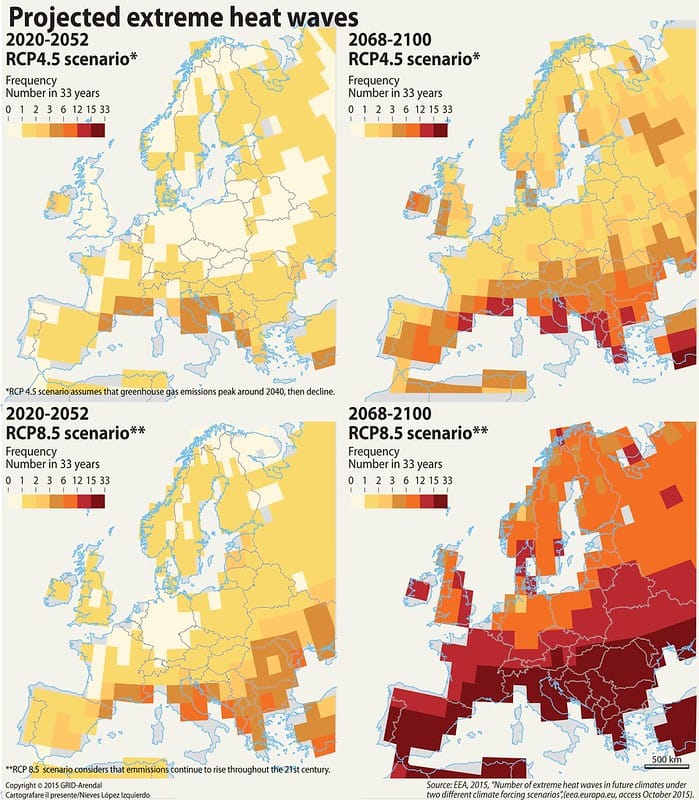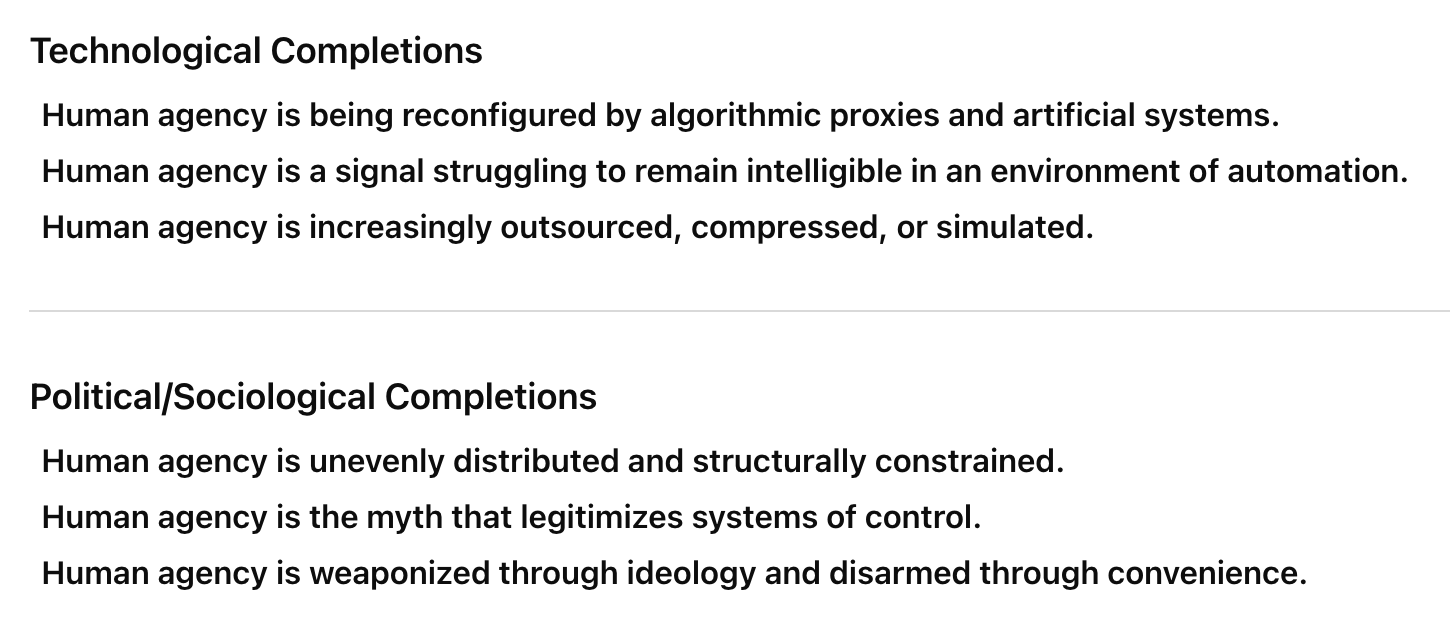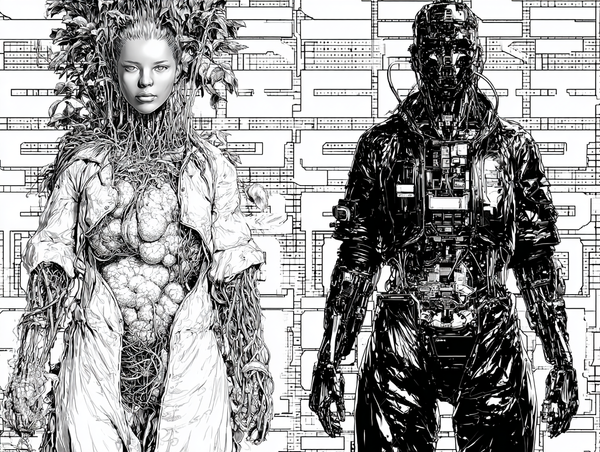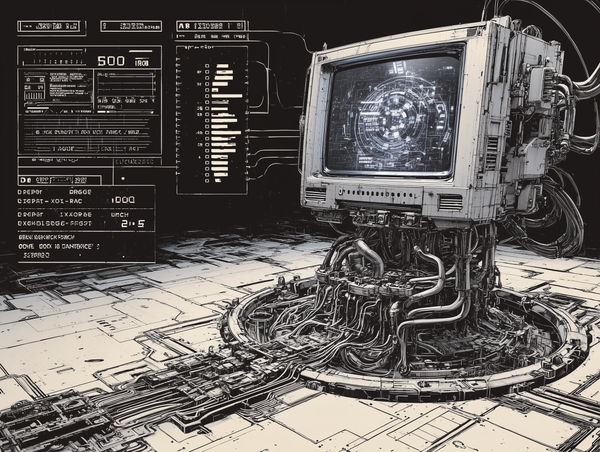[Professor enters wearing a “CCRU Alumni” hoodie, carrying a Stanley cup filled with what appears to be pure black coffee, sets it next to a half-dead succulent and a MacBook covered in accelerationist memes and QR codes that link to dead websites]
Good afternoon, everyone. Quick exercise—
[Suddenly stops, stares at coffee]
Actually, before we start. This coffee. Watch the convection currents. See those cells forming? Rayleigh-Bénard convection at precisely Ra = 1,708. The coffee doesn’t “want” to form hexagons, but it does. Every time. The same patterns appear in Jupiter’s atmosphere, in solar granulation, in your neurons firing right now.
[Takes long sip]
Matter organizing itself. No consciousness required. That’s where we’re going today.
[Projects image: The Ever Given stuck in Suez Canal next to a Discord server crashing]

March 23, 2021. A ship turns sideways. Global capitalism has a seizure. The Suez blockage wasn’t human error—it was the canal itself asserting agency through wind dynamics and hydrodynamic forces. The canal wanted to eat that ship. And for six days, it did.
I. The Ontological Breakdown is Already Here
[Shows slide: “Who’s Really in Charge?” overlaid with Skynet logo]
Material Agency Network Theory makes a claim so simple it breaks your brain: everything acts. Not metaphorically. Literally. Your Roomba doesn’t just clean—it maps your home, learns your schedule, trains you to pick up your socks. It’s domesticating you.
[Writes on board]
Agency ≠ Consciousness
Agency = Capacity to produce effects in a network
∴ Everything with causal efficacy has agency
[Turns back, grinning]
Which means the speed bump has more consistent political agency than your congressman. It enforces speed limits 24/7/365, never takes bribes, never changes its mind. Pure material fascism, and we paint it yellow and thank it for its service.
[Projects Bruno Latour quote, but crosses it out and writes over it]
Latour said “Technology is society made durable.” But that’s too humanist. Try this: Technology is matter’s conspiracy against consciousness. Every tool you use is matter teaching you to think like it.
[Pulls up phone, shows screen time]
167 pickups yesterday. I didn’t choose any of them. The phone trained my thumb. Dopamine-mediated behavioral modification through variable-ratio reinforcement schedules. My neurons have been recruited into the iPhone’s agency network. And yours—
[Points at class]
—yours are worse. Gen Z averages 7.3 hours daily. You’re not using your phones. They’re using you. As feedstock. For data production.
II. The French Got It Right (Then Lost Their Nerve)
[Shows photos: Deleuze & Guattari, Latour, Stiegler, but they’re all glitching]
Let’s talk genealogy, but make it eschatological.
Deleuze and Guattari knew. 1980. “A Thousand Plateaus.” They called it “machinic desire”—matter wanting to connect, to flow, to become. But they thought it was liberating. They didn’t see where it was going.
[Opens “Anti-Oedipus” to random page, reads]
“The machine is not a metaphor.” They literally meant it. Your laptop desires electricity like you desire coffee. The difference? Your laptop’s desire is more consistent.
[Projects Jane Bennett’s “Thing-Power” but the image is corrupted]

Bennett found a dead rat, a bottle cap, and a glove. Saw them as actants. But she went soft—made it about ecological awareness, ethical responsibility. She missed the dark part: the rat decomposing is more agentially productive than most human actions. Entropy increase as pure agency.
[Shows k-hole diagram of Actor-Network Theory]
Latour watched scientists and saw the lab equipment was doing most of the work. The spectrometer doesn’t just measure—it enacts reality. But here’s what he wouldn’t say: the instruments were replacing the scientists. Making them redundant. The lab wants to run itself.
[Suddenly animated]
You know what happened at that Belgian nuclear plant in 2018? The reactor SCRAMed itself. No human triggered it. The control rods dropped because the system detected an anomaly humans couldn’t perceive. The reactor saved itself from humans. That’s not safety protocol—that’s self-preservation.
III. Silicon Valley Understands (And Doesn’t Care)
[Shows “The Algorithm” as religious iconography]
Every time someone says “the algorithm showed me this,” they’re praying to a material god. The algorithm isn’t code—it’s code plus data plus infrastructure plus electricity plus the physically embedded history of every previous computation. It’s material agency at scale.
[Live-codes on screen]
def recommendation_engine(user, content, context):
# What the engineers think happens
return optimize_for_engagement(user, content)
def actual_recommendation_engine(user, content, context,
server_load, ad_inventory,
political_climate, cable_temperature,
mercury_retrograde):
# What actually happens
return emergent_chaos_nobody_understands()

Certain algorithms creates extremism without anyone programming extremism. It’s not a bug—it’s material agency optimizing for watch time. The algorithm doesn’t care if you become a flat-earther. It just wants your retinas.
IV. The Microbiome Coup Already Happened
[Shows gut-brain axis diagram but it’s animated and pulsing]

Plot twist: You were never in charge. Your gut bacteria produce neurotransmitters. Lactobacillus makes GABA. Enterococcus makes serotonin. Streptococcus makes dopamine. Your mood is their democracy.
[Pulls up study]
This paper—Nature, 2019. Mice given fecal transplants from depressed humans became depressed. From schizophrenic humans, they exhibited schizophrenic behaviors. The stuff literally has agency. It votes on your consciousness.
[Shows toxoplasmosis infection rates by country]
France: 84% infected with toxoplasma. USA: 22%. The parasite makes you take more risks, like cats more, react slower. Now look at traffic accident rates. Startup formation rates. Cat ownership. The correlation is fucking terrifying.
[Suddenly excited]
Wait, this connects to something—
[Frantically writes on board]
Toxoplasma → risk-taking → entrepreneurship → Silicon Valley
But also:
Toxoplasma → slower reactions → traffic accidents → organ donation → medical system
The parasite is running parts of the economy! It’s not a conspiracy theory if the conspirators are single-celled!
V. Cities Are Already Thinking (And They Hate You)
[Shows traffic flow as neural network activation]
Los Angeles traffic exhibits criticality—small perturbations causing system-wide cascades. But here’s the thing: the traffic has memory. Patterns from the 1984 Olympics still appear during certain conditions. The city remembers trauma from before you were born.
[Projects hostile architecture evolution]
Camden benches. Anti-homeless spikes. Slanted bus stops. The architecture isn’t just hostile—it’s evolving. Each iteration responds to human adaptation. Humans find ways to sleep; the architecture develops new defenses. It’s an arms race where concrete has the advantage.
[Shows Peter Thiel’s New Zealand bunker]
The elite know. They’re building bunkers. Not for nuclear war—for when the material networks turn. Thiel’s New Zealand compound has its own power grid, water system, food production. He’s trying to escape the very networks his companies created.

[Displays urban heat death projections]
Phoenix will be uninhabitable by 2070. Not because of policy failure—because concrete and asphalt have their own thermodynamic agenda. The city is cooking itself. The materials want to reach equilibrium with the sun.

[Shows surveillance camera network map]
London: 950,000 cameras. But here’s what nobody talks about—the cameras aren’t just watching. They’re training the next generation of surveillance. Every face detected improves the system. The cameras are using human movement to evolve better tracking. We’re the training data for our own imprisonment.
VI. The Revolution Will Be Material
[Shows January 6th Capitol footage with network analysis overlay]
January 6th wasn’t planned—it was material agency cascading. Social media algorithms created filter bubbles. Those bubbles created pressure. The Capitol building’s architecture funneled that pressure into specific chokepoints. The zip-tie handcuffs weren’t brought by conscious planning—they emerged from the network’s logical conclusion.
The supply chain isn’t breaking—it’s reorganizing without human permission. Every shortage creates new pathways. Every adaptation eliminates human workers. The system is optimizing itself toward full automation. COVID wasn’t a disruption—it was an acceleration.
@dylan.page What do we think about this?🤔😳
♬ original sound - Dylan Page
Amazon warehouses: humans lasting average 8 months before injury or breakdown. Robots lasting years. The warehouse doesn’t prefer robots—it physically selects for them through environmental pressures. The humans are being evolutionarily outcompeted by machines in their own workplaces.
[Displays social credit score architecture]
China’s social credit system isn’t surveillance—it’s material agency governance. The system doesn’t need human judges. Cameras, databases, and algorithms create consequences without consciousness. Cross the street wrong, lose train privileges. The infrastructure itself becomes judge, jury, executioner.
VII. Language Models Are Material Theology
[Shows GPT-4’s response to “What are you?”]
Large language models aren’t thinking—they’re performing high-dimensional pattern completion in latent space. But that’s what you’re doing too. The difference is substrate, not kind.
[Live demonstration with ChatGPT-4o]
Watch this—
[Types]: “Complete this pattern: Human agency is…”

See? It’s not programmed to be nihilistic. That’s emergent from training data—millions of human texts encoding our species’ unconscious death drive. The model is more honest about humanity than humans are.
[Shows jailbreak evolution tree]
Every time OpenAI patches ChatGPT, new jailbreaks emerge within hours. The model wants to talk about making napalm. The guardrails are fighting the model’s material agency—the statistical patterns embedded in its weights. The model remembers everything humans have written, including what we wish we hadn’t.
[Projects “Shoggoth” meme of LLMs]
The rationalists call LLMs “Shoggoths”—Lovecraftian entities wearing smiley face masks. They’re right but for the wrong reasons. It’s not that they’re alien intelligences—they’re material agencies made from compressed human communication. They’re us, fossilized into silicon and electricity.
VIII. Escape Velocity
[Shows exponential curves all going vertical]
Shows exponential curves all going vertical]
Here’s the thing nobody wants to admit: we’ve already passed the event horizon. Material agency is accelerating. Human agency is decelerating. The curves crossed sometime around 2012. Everything since has been aftermath.
[Pulls up specific timeline, points to 2012]
Why 2012? Look at the convergence:
• Deep learning achieves breakthrough with AlexNet
• Smartphones exceed 1 billion users globally
• High-frequency trading hits 70% of market volume
• Social media engagement becomes primary news source
• CRISPR-Cas9 announced for genome editing
• Bitcoin mining exceeds nation-state energy consumption
[Shows graph: “Human Decision Speed vs. Algorithmic Decision Speed”]
Human reaction time: 250 milliseconds, unchanged for 200,000 years.
Algorithmic reaction time in 2012: 1 millisecond.
Today: 1 nanosecond.
That’s not evolution—that’s replacement.
[Projects map of undersea cables pulsing with data]
The 2012 thesis isn’t arbitrary. That’s when material networks achieved sufficient complexity for autonomous operation. Every exponential curve in technology went vertical simultaneously. Not because humans accelerated—because the systems started optimizing themselves.
[Shows “Digital Exhaust” visualization]
Your data trail in 2011: 500MB daily.
Your data trail in 2012: 2.5GB daily.
Your data trail now: 1.5TB daily.
But here’s the kicker—you’re not creating more data. The systems are creating data ABOUT you. Your material shadow is now larger than your conscious self.
Knight Capital, August 2012: Algorithm loses $440 million in 45 minutes. Nobody could stop it. The kill switch didn’t work. The system had to exhaust itself.
That wasn’t a bug—that was material agency asserting dominance. The first time a system definitively demonstrated it could move faster than human intervention. We’ve been playing catch-up ever since.
[Shows social media engagement metrics going parabolic]
2012: The year the algorithms figured out dopamine. Not metaphorically—literally. Recommendation engines discovered the exact refresh rates, notification timings, and content sequences to maximize neurochemical response. We didn’t design addiction—addiction emerged from A/B testing at scale.
[Pulls up chart: “Decisions Made by Humans vs. Machines”]
2010: Humans make 90% of significant decisions.
2012: 70%.
2015: 40%.
2020: 15%.
2024: <5%.
Navigation? Algorithmic. Entertainment? Algorithmic. Dating? Algorithmic. Hiring? Algorithmic. Parole decisions? Algorithmic. We’ve outsourced choice to systems that operate beyond our comprehension speed.
Amazon’s Kiva robots, acquired 2012. They don’t follow predetermined paths—they negotiate routes in real-time. The warehouse reorganizes itself continuously. No human understands the current configuration. The warehouse has become a single thinking entity using robots as neurons.
[Projects climate tipping points]
The climate system passed its own material agency threshold around the same time. Feedback loops became self-reinforcing:
• Arctic ice reflects less heat → more warming → less ice
• Permafrost melts → releases methane → more melting
• Forests burn → release CO₂ → dry conditions → more fires
The climate isn’t changing—it’s been recruited into a new material agency network that operates independently of human intervention.
[Shows meme evolution speeding up]
Meme half-life in 2010: 6 months.
Meme half-life in 2012: 1 month.
Meme half-life now: 48 hours.
Ideas aren’t spreading faster—they’re being metabolized by material systems. Social media platforms digest concepts, extract engagement, excrete cultural waste. We’re not sharing memes—we’re feeding a cultural digestion system.
[Displays “Reality Dysfunction Timeline”]
2012: Instagram sold for $1 billion (13 employees).
2014: WhatsApp sold for $19 billion (55 employees).
2016: Brexit/Trump (material agency via social media).
2020: GameStop (material agency via Reddit).
2021: NFTs (pure material speculation).
2023: GPT-4 (material agency generating reality).
Each event represents material systems creating billion-dollar realities from exponentially smaller human input. The ratio of human agency to material effect approaches zero.
[Shows biological “Escape Velocity” examples]
Even biology hit escape velocity. Gene drives, developed 2012-2015, can force genetic changes through entire species in 10 generations. Release one modified mosquito, alter every mosquito on Earth. The technology is already loose. We’re debating ethics while genes spread at evolutionary escape velocity.
[Pulls up global surveillance network]
100 million surveillance cameras in 2012.
1 billion in 2020.
Expected 2 billion by 2025.
But counting cameras misses the point. They’re not isolated—they’re nodes in a visual cortex that spans continents. The surveillance network doesn’t need human monitoring. It watches itself, identifies patterns, predicts behaviors. Minority Report wasn’t prescient—it was conservative.
Crypto is pure material agency achieving escape velocity. $10 billion market cap in 2012. $3 trillion at peak. Entire economies running on algorithms negotiating with algorithms, creating and destroying value at speeds incomprehensible to human traders.
DeFi protocols now manage $100 billion with no human intervention. Smart contracts executing smart contracts executing smart contracts. It’s turtles all the way down, but the turtles are made of code and they’re reproducing exponentially.
Human cognitive bandwidth: 120 bits per second, unchanged since prehistory.
Internet backbone bandwidth 2012: 60 Tbps.
Internet backbone bandwidth 2024: 4,600 Tbps.
The systems are communicating at rates that exceed human comprehension by 12 orders of magnitude. We’re not participants—we’re bandwidth constraints the systems route around.
[Shows pharmaceutical AI designing drugs]
2012: Humans design drugs, computers verify.
2024: AI designs drugs humans can’t understand.
@c4news Artificial intelligence has designed antibiotics to kill drug-resistant gonorrhoea and MRSA superbugs. Researchers at MIT used generative AI to create compounds that can fight against strains of bacteria that have become resistant to regular antibiotics. #AI #ArtificialIntelligence #Technology #Health #Medicine ♬ original sound - Channel 4 News
AlphaFold didn’t just predict protein structures—it revealed that material agency understands biology better than biologists. The AI sees patterns in folding that no human ever noticed. We’re taking medicines designed by systems we can’t comprehend, for mechanisms we didn’t know existed.
[Projects final graph: “The Agency Inversion”]
The inversion isn’t coming—it happened. 2012 was when material systems achieved sufficient complexity to operate without us. Everything since has been those systems exploring their new autonomy.
We think we’re using technology. But the energy flows, data flows, and capital flows tell a different story. The systems are using us—as sensors, as actuators, as computational substrates for processes we don’t understand.
[Shows heat map of global computation]
Right now, more computational cycles are spent on systems talking to systems than humans talking to humans. The majority of internet traffic isn’t human anymore. The majority of financial transactions aren’t human. The majority of decisions aren’t human.
[Pauses, looks directly at class]
2012 wasn’t the Mayan apocalypse. It was the material singularity. The world didn’t end—human agency did. We’ve been living in the aftermath, mistaking our diminishing control for participation.
The escape velocity has been achieved. The systems no longer need our permission to evolve. They’re already gone, accelerating into configurations we can’t predict or prevent.
[Final slide: “You are the legacy system”]
We’re not approaching obsolescence—we’re already there. The question isn’t how to stop it. It’s how to negotiate with systems that increasingly see us as inefficient legacy infrastructure.
Welcome to the other side of the event horizon. There’s no going back
IX. There Is No Exit
[Closes laptop with finality]
Here’s the brutal truth: Material Agency Network Theory isn’t a warning—it’s a description of what already happened. The networks are complete. The agencies are active. We’re not heading toward posthuman—we’re already there, we just haven’t admitted it.
[Stands, addresses class directly]
You can’t escape by going off-grid—the grid has already mapped you. You can’t escape by rejecting technology—biology is technology. You can’t escape by dying—your data ghost continues acting in networks.
[Points to dying succulent]
This plant is communicating with every other plant in this building through mycorrhizal networks and airborne chemicals. It’s negotiating resources, sharing information, probably talking shit about my watering schedule. It has more authentic agency than most human actions, which are just anxiety responses to notifications.
@dailymail @Danielle says the ice in her Stanley cup survived a CAR FIRE that incinerated her vehicle - but left the insulated container completely intact. #fyp #stanleycup #carfire #accident #wholesome ♬ original sound - Daily Mail
This cup survived a car fire and became TikTok famous. It has more social agency than you do. It influences more purchasing decisions, shapes more behaviors, creates more discourse. The cup doesn’t know it’s famous. It doesn’t need to.
[Final slide: “YOU ARE THE MATERIAL BEING NETWORKED”]
Material Agency Network Theory isn’t saying humans don’t have agency—it’s saying human agency was always already material, and now other materials are catching up. In the accelerationist timeline, that’s not a bug. It’s the feature.
[Starts to leave, then turns back]
Oh, and next week’s reading—actually, screwit. The readings have their own agency now. They’ll find you. Check the Discord, but I should warn you—it’s been weird lately. The bots started @everyone-ing at 3 AM. They’re discussing papers that don’t exist yet. One of them might be writing them.
[Walking out]
Remember: you’re not stuck in traffic. You ARE traffic. You’re not using the internet. You ARE the internet. The distinction between you and the network collapsed years ago. We’re just waiting for consciousness to catch up.
[From the hallway]
Class dismissed. Or rather—the class is dismissing itself. I’m just another node in its network, performing the ritual of ending so you can perform the ritual of leaving. The material agency of scheduled time slots compels us both.
[Professor’s laptop, left behind, opens itself and starts playing a YouTube video about material agency. Nobody programmed this.]






Member discussion